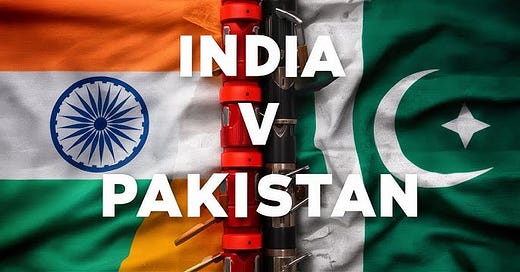Assessment of the May 2025 India–Pakistan Military Escalation and the Risk of Full-Scale Conflict
Prepared by Evarist Chahali
Assessment of the May 2025 India–Pakistan Military Escalation and the Risk of Full-Scale Conflict
Executive Summary
In May 2025, tensions between India and Pakistan escalated dangerously following a devastating terror attack in Kashmir and retaliatory Indian missile strikes deep into Pakistani territory. Both nations—armed with nuclear weapons—have since exchanged artillery fire, closed airspace, and mobilised forces along the Line of Control (LoC).
This Ujasusi Blog intelligence report evaluates the current threat environment and provides strategic insights into whether the world is edging toward an all-out India–Pakistan war. The analysis indicates that while both sides are exercising calibrated military posturing, the risk of miscalculation or inadvertent escalation remains dangerously high.
1. Strategic Context: Kashmir, Terrorism, and the Path to May 2025
The enduring India–Pakistan conflict, rooted in territorial disputes over Kashmir, has been punctuated by wars (1947, 1965, 1971, 1999) and regular cross-border skirmishes. The presence of nuclear weapons since 1998 has deterred full-scale war but failed to prevent crises triggered by terrorist attacks.
On 22 April 2025, a militant group attacked pilgrims in Pahalgam, killing 26 civilians. India attributed the massacre to Pakistan-based Lashkar-e-Taiba. The Pakistani government denied responsibility, escalating the diplomatic fallout.
In retaliation, India launched Operation Sindoor on 6 May 2025, striking alleged terrorist sites in Muzaffarabad, Kotli, and Bahawalpur using standoff missile platforms. This marked India’s most significant kinetic action since the 2019 Balakot strikes.
2. Military Posture and Escalation Signals
Following India’s strikes, Pakistan declared the operation an “act of war.” The military response included:
Heavy artillery fire along the LoC
Claims of downing Indian aircraft, including a Rafale jet (unverified)
Suspension of commercial flights
Emergency declarations in border provinces
India responded with troop reinforcements and continued aerial surveillance. Open-source imagery confirms military convoys near sensitive sectors, while air defences remain active on both sides.
Despite intense skirmishes, both nations have so far avoided striking core military installations or urban centres—suggesting a controlled escalation strategy.
3. The Nuclear Shadow: Doctrine and Deterrence
Both India and Pakistan maintain nuclear arsenals capable of strategic and tactical strikes.
India’s nuclear doctrine: No First Use (NFU), with a promise of massive retaliation in response to any nuclear attack.
Pakistan’s doctrine: No declared NFU; “full spectrum deterrence” allows for battlefield use in case of existential threats.
India’s use of precision-guided weapons within a narrow scope indicates a deliberate effort to avoid provoking Pakistan’s nuclear red lines. However, continued tit-for-tat exchanges increase the probability of miscalculation, particularly if one side suffers heavy losses or misreads enemy intentions.
4. Political Incentives and Domestic Narratives
India:
Prime Minister Modi, facing public anger after the Pahalgam killings, has capitalised on Operation Sindoor to project strong leadership. Domestically, the operation has been framed as a counterterrorism success.
Pakistan:
Pakistan’s government and military are under pressure to respond without risking a wider war. Islamabad is relying on publicised claims of Indian aircraft losses to assert deterrence while avoiding disproportionate escalation—for now.
In both countries, nationalist rhetoric risks inflaming public opinion beyond the threshold of diplomatic control.
5. International Response: Pressure for De-escalation
Global powers are deeply alarmed by the possibility of war between two nuclear states:
United Nations: Urged immediate restraint; warned of “unacceptable” regional consequences.
United States: Privately engaged both sides; India reportedly briefed Washington prior to strikes.
China and Russia: Issued statements supporting regional stability and behind-the-scenes mediation.
Gulf States and EU: Offered to facilitate dialogue.
Pakistan’s economic vulnerability, including reliance on Gulf support and IMF loans, constrains its escalation options. India, pursuing global leadership ambitions, is also under pressure to show restraint after retaliation.
6. Intelligence-Based Threat Outlook
🔥 Likelihood of Full-Scale War: Moderate
Limited military strikes and artillery duels are ongoing. However, neither side appears ready to initiate a conventional war across the international border—yet. Should retaliatory cycles escalate further or result in significant civilian or military losses, all-out war becomes plausible.
☢ Likelihood of Nuclear Conflict: Low but Present
There are no signs of imminent nuclear deployment. But, if Pakistan perceives a collapse of conventional deterrence or territorial invasion, tactical nuclear use may be considered. India's nuclear posture would then trigger massive retaliation, with catastrophic consequences.
🧭 Next 72 Hours: Critical
Escalation may be halted if Pakistan’s response remains symbolic and India refrains from further strikes. Intelligence agencies are monitoring:
Missile movements
Force mobilisations
Strategic airbase activity
Political signals for war readiness
7. Conclusion: Calibrated Crisis or Countdown to Catastrophe?
India and Pakistan have entered a high-risk phase of armed confrontation under the nuclear threshold. Each seeks to maintain domestic credibility and strategic deterrence, while avoiding open war. However, this balancing act is increasingly precarious.
Unless third-party diplomacy intervenes successfully and both nations resist escalation, the situation could spiral into South Asia’s most dangerous military conflict in decades.




